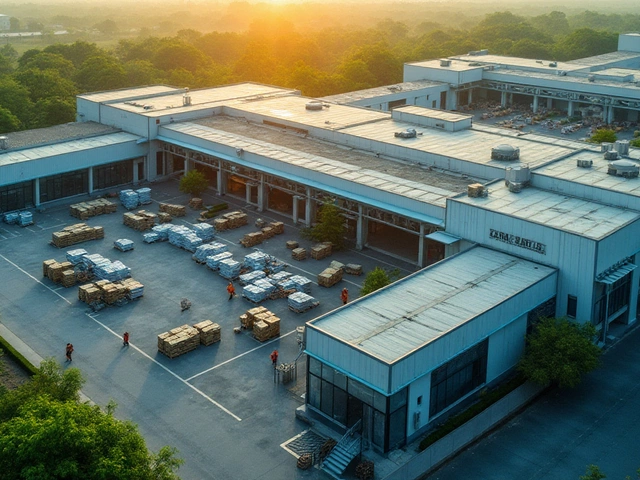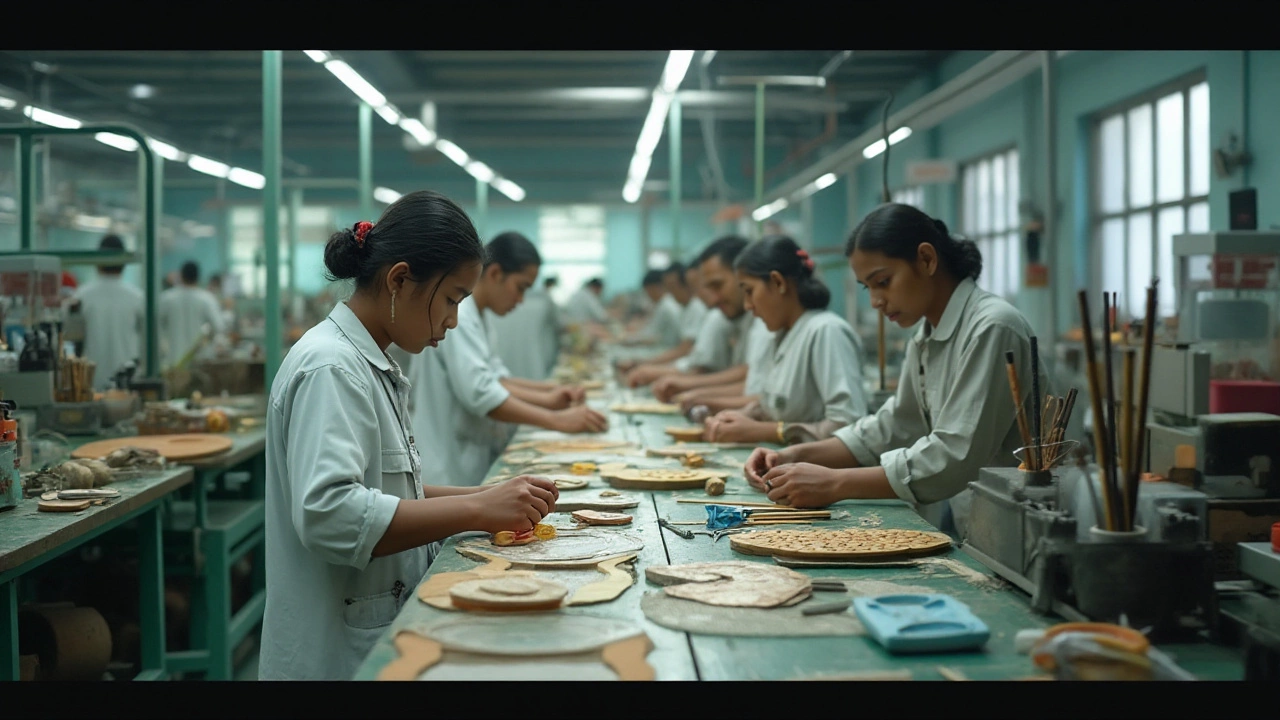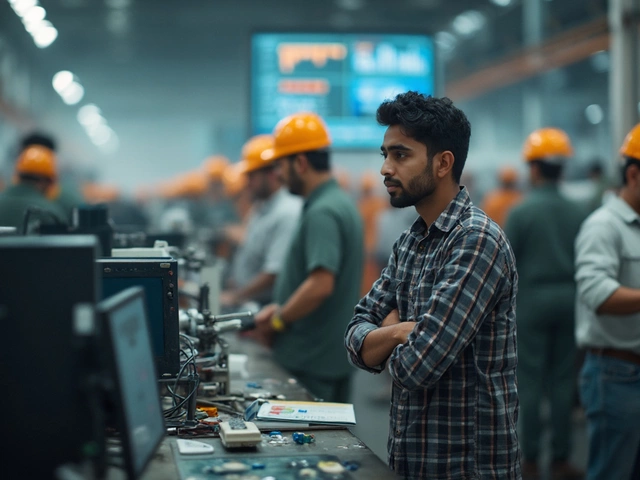In the rapidly evolving landscape of 2024, manufacturing continues to offer substantial opportunities for growth and profitability. Today, savvy entrepreneurs are seeking not just any business, but those that harness innovation and market trends to generate significant profits.
This article explores some of the most profitable manufacturing business ideas you can consider today. From innovating in niches with high demand to capitalizing on sustainable practices, we'll delve into several ideas that align with contemporary consumer interests and technological advancements. Whether you're just starting or looking to diversify, understanding these opportunities could be your first step towards a successful manufacturing venture.
- Understanding Market Trends in Manufacturing
- Top Profitable Manufacturing Ideas
- Benefits of Personalized Manufacturing
- Sustainability and Its Profitability
- Steps to Start a Manufacturing Business
Understanding Market Trends in Manufacturing
Manufacturing is the backbone of modern economies, driving innovation and providing jobs worldwide. As of 2024, several key trends are shaping the landscape, making it crucial for entrepreneurs and established companies alike to pay attention. One of the most significant trends is the shift towards sustainable practices. Consumers and governments are pushing for greener manufacturing processes, and businesses that align with this demand often see a boost in public approval and, consequently, in sales. This emphasis on sustainability isn't simply a fad but a movement gaining legal and social momentum, compelling industries to rethink their environmental impact.
Another critical trend involves technology integration, particularly through Industry 4.0. This includes the adoption of the Internet of Things (IoT), artificial intelligence, and machine learning to streamline production, boost efficiency, and enhance quality control. These technologies enable predictive maintenance, thus reducing downtime and maximizing output. As technology continues to advance, we are seeing smarter factories driving productivity to new heights. A recent study by Deloitte highlights this transformation, indicating that companies employing these advanced technologies are seeing margins improve by up to 30%.
"The future of manufacturing lies in adaptive, smart ecosystems," states the World Economic Forum's 2023 report on global industries. "Businesses that harness digital integration within their manufacturing processes significantly outpace their competitors who lag behind in technology adoption."
Additionally, the trend of customization and personalization is carving a niche in manufacturing. Brands that offer personalized products often see increased customer loyalty and unique market positioning. This trend is partly fueled by advancements in digital technology, such as 3D printing, which allows for mass customization at lower costs. As the demand for unique experiences grows, businesses that can deliver personalized products efficiently are outpacing those that stick to traditional, rigid processes.
It is also important to note the gradual yet significant development of global supply chains. Driven by geopolitical tensions, natural disasters, and the lessons learned from recent global disruptions, businesses are re-evaluating their supply networks to mitigate risks. Localized manufacturing is seeing a resurgence as companies seek to shorten supply chains and increase resilience, which, in turn, can reduce costs and enhance reliability.
This rapidly shifting landscape creates both challenges and opportunities. To thrive, manufacturers must remain agile, constantly scanning the horizon for emerging trends and adjusting their strategies accordingly. By embracing technologies, sustainability, and consumer-centric processes, businesses can not only keep up with the changes but set themselves apart as leaders in the field.
Top Profitable Manufacturing Ideas
Manufacturing is a cornerstone of economic growth and a pivotal sector for entrepreneurs looking to capitalize on modern trends. As 2024 unfolds, innovation in this industry brings to light several opportunities that hold promising prospects for profitability. Among the leading contenders is the electric vehicle (EV) component manufacturing sector, driven by the global shift toward sustainable transport solutions. With the International Energy Agency anticipating electric vehicles to constitute over 20% of global vehicle sales by 2025, manufacturers producing batteries, chargers, and other components are poised to enjoy increasing market demands.
Another burgeoning field is 3D printing, which continues to revolutionize how products are made and distributed. This technology, once limited to prototyping, has now permeated production processes across various industries from healthcare to automotive. The ability to customize and rapidly produce parts without the traditional tooling costs makes it a lucrative option for start-ups and established businesses alike. According to a report by MarketsandMarkets, the 3D printing industry is expected to grow at a CAGR of 21% from 2023 to 2028, highlighting significant profit potential.
The Rise of Eco-friendly Alternatives
Environmental consciousness is no longer a trend but a necessity, and this has catalyzed the rise of sustainable manufacturing. Companies that produce biodegradable products, such as packaging materials or eco-friendly cleaning agents, see increasing interest from both consumers and retailers. This shift is not only driven by regulatory policies worldwide but by consumers who are now more willing to pay a premium for green products. Embracing sustainable practices can therefore mean tapping into a larger, more loyal customer base.
According to the Boston Consulting Group, companies leading in the adoption of sustainable practices are projected to achieve a 12% higher profit margin over those who lag behind.
Personalized Goods and Niche Markets
Personalization has captured the imagination of buyers across the globe, transforming the way consumers interact with brands. Today, businesses that offer bespoke and custom products are gaining a competitive edge, be it in fashion, home decor, or even tech gadgets. Manufacturing tailored products allows companies to connect deeply with niche markets and retain a devoted customer base. For instance, personalized jewelry and custom-designed apparel not only command higher prices but also foster customer loyalty, making them highly profitable sectors.
The above ideas underline the importance of aligning manufacturing activities with evolving market landscapes. Whether one chooses to produce cutting-edge technology components or environmentally friendly goods, the key to success lies in assessing market needs and innovating accordingly. As we navigate through 2024, these profitable manufacturing ideas can guide aspiring entrepreneurs and established business players alike in making informed decisions on where to invest their efforts and resources.

Benefits of Personalized Manufacturing
Personalized manufacturing is rapidly revolutionizing the industry landscape, offering a slew of advantages that appeal to both producers and consumers alike. In essence, it allows businesses to cater to individual consumer preferences, fostering a higher degree of customer satisfaction and loyalty. By focusing on tailored solutions, companies can stand out in a crowded marketplace. The rise of technologies like 3D printing and advanced robotics has made customization more accessible and cost-effective than ever. In fact, this shift towards personalization is not just a trend; it is fast becoming a necessity in various sectors, from fashion to electronics.
This manufacturing approach leads to a notable boost in product differentiation, setting businesses apart from their competitors. Offering customized options gives consumers the chance to feel involved in the creation process, often resulting in stronger brand loyalty. Additionally, personalization can lead to a higher profit margin since customized products tend to have a perceived higher value among customers. It helps in meeting the specific needs and desires of each consumer, allowing businesses to charge a premium price.
According to McKinsey, "Personalized manufacturing is no longer optional; it is an imperative strategy to ensure future growth and consumer connectivity."
Adopting personalized manufacturing methods can also reduce waste, as products are made based on actual demand rather than forecasts. This factor resonates well with the growing consumer base that prioritizes sustainable practices. By precisely producing what the market desires, businesses minimize overproduction and excessive inventory. Moreover, this method provides a valuable resource for learning about consumer preferences through data that can be collected and analyzed. Companies can use this data to anticipate market trends and proactively adapt their strategies.
Furthermore, by embracing personalization, manufacturers are in a better position to innovate. This dynamic approach fosters an environment where customer insights drive product development, encouraging creativity and new solutions. Companies may also leverage personalized manufacturing to explore niche markets that were previously unattainable. This strategic move not only opens new revenue streams but also strengthens the brand's position in specialized areas. Above all, these benefits culminate in enhanced competitive advantage, making personalized manufacturing a formidable strategy in today's business environment.
Sustainability and Its Profitability
Today, embracing sustainability isn't just about a responsibility to the planet—it's also a smart business move. More than ever before, consumers are looking for products that do not harm the environment. This shift in consumer consciousness has opened up extensive opportunities within the manufacturing sector, where businesses that incorporate eco-friendly practices can often see substantial gains. Think about it: a factory that recycles its water not only reduces waste but also cuts down on operational costs. The demand for sustainable goods has never been higher, with statistics revealing a yearly growth rate of over 10% in markets specifically focusing on environmentally friendly products.
One of the most profound transformations is seen in materials and production methods. Innovators are investing heavily in green technologies that not only reduce environmental impact but also align with the financial goals of modern businesses. Consider Tesla's approach to manufacturing, often referenced in sustainability discussions. Elon Musk once said, "Sustainable energy is the future, and the future must be bright." This ethos contributes to their immense success, as investors and consumers alike are keen to engage with companies that promise and deliver sustainable production techniques.
The profitability of sustainability can also be linked to compliance with government regulations, which are increasingly favoring green practices. Numerous countries are implementing stricter environmental policies, offering incentives such as tax breaks or subsidies to businesses that go green. This move not only signifies a way to lower costs but also provides opportunities for expansion and innovation that are otherwise unavailable. Businesses that not only meet these regulations but go beyond them often gain competitive advantages, attracting clients who prioritize eco-conscious decisions.
Moreover, the concept of a circular economy is rapidly gaining traction, marked by the recycling and reusing of materials to extend their lifecycle as opposed to the traditional linear model of make-use-dispose. This shift towards a closed-loop system can lead to innovations in manufacturing processes, reducing waste and increasing efficiency. Companies that successfully integrate these concepts into their operations not only contribute positively to the environment but also reap economic benefits by reducing dependency on raw materials.
For those looking to dive into sustainable manufacturing, understanding market demands and potential profitability through data-driven decision-making is crucial. Entrepreneurs and established companies need to focus on building partnerships with suppliers and distributors that share similar values, ensuring that the sustainability promise extends throughout the supply chain. By doing so, businesses can better position themselves as leaders in this emerging, lucrative market. The key to maximizing profitability will lie in transparency, innovation, and the continuous pursuit of reducing the ecological footprint of their operations. After all, sustainability is not just a trend, but a lasting shift in how we view and utilize earth's resources.

Steps to Start a Manufacturing Business
Launching a manufacturing business in today's dynamic market requires a blend of strategic planning, resource management, and innovative thinking. To get started, the first crucial step is conducting thorough market research. Understand the trends driving the demand for certain products, analyze your competitors, and pinpoint gaps in the market that you could fill. This information forms the backbone of your business plan, shaping your ideas and guiding your initial decisions.
An essential component of starting any business, particularly in manufacturing, is the creation of a comprehensive business plan. This plan should detail your business objectives, financial projections, marketing strategies, and operational plans. It's more than just a document for potential investors; it's a roadmap that can steer every decision you make. Remember to include detailed SWOT analysis, which helps identify strengths, weaknesses, opportunities, and threats. This analysis is invaluable in crafting strategies that align with your company's goals.
Theodore Levitt once said, "Creativity is thinking up new things. Innovation is doing new things."
Once your business plan is in place, you must focus on securing the necessary funding. This could involve traditional bank loans, seeking venture capital, or even exploring crowdfunding options. The manufacturing industry often requires significant upfront investment for equipment and raw materials, so a clear financial strategy is pivotal. Your ability to manage finances effectively will influence everything from operational efficiency to product pricing and expansion opportunities.
With funding secured, selecting the right location for your manufacturing facility becomes the next critical task. This decision can affect logistics, production costs, and your ability to attract and retain skilled workers. Consider factors such as proximity to suppliers and customers, availability of skilled workforce, and local regulations at play when making this decision. Also, keep in mind that your facility needs to comply with health and safety regulations, which ensures both the wellbeing of your employees and the quality of your products.
The final stages involve acquiring the necessary machinery and raw materials. This step requires meticulous planning. Opt for equipment that not only fulfills current production requirements but also offers room for scalability as your business grows. Establish strong relationships with reliable suppliers to ensure a steady flow of quality raw materials into your facility. A disruption in supply can stall production and damage customer relationships. Additionally, investing in high-quality machinery and materials can significantly impact the profitability and reputation of your product line.
Once the groundwork is laid, assembling a skilled team becomes essential. The right employees can drive innovation and efficiency, fostering a workplace environment that values craftsmanship and productivity. Invest in employee training programs to keep skills sharp and your team informed about the latest industry trends and technologies. A well-trained team can help you adapt to market changes swiftly and ensure a high standard of quality in your manufacturing processes.







Write a comment